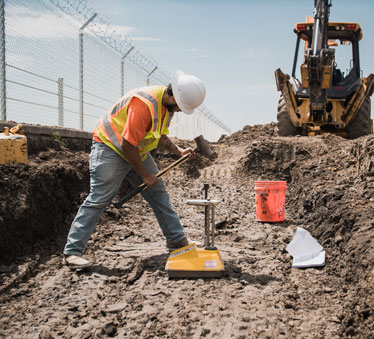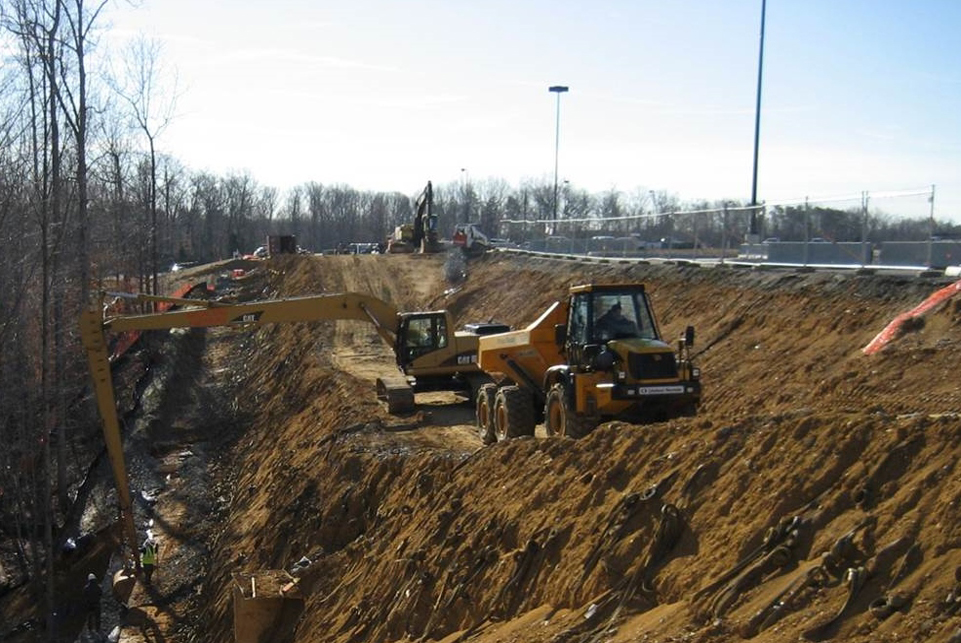How Geo Tech Engineering Sustains Large-Scale Construction Projects
How Geo Tech Engineering Sustains Large-Scale Construction Projects
Blog Article
The Vital Payments of Geotechnical Designers in Examining Soil Habits and Structure Style for Lasting Infrastructure Growth
Geotechnical designers serve as a keystone in the world of lasting facilities advancement, where their know-how in examining soil behavior straight influences the safety and long life of structures. By employing sophisticated methods such as Standard Penetration Tests and Cone Infiltration Screening, they diligently review soil residential or commercial properties, leading to informed decisions on structure layout.
Duty of Geotechnical Engineers

In addition to website investigations, geotechnical engineers examine potential risks such as dirt liquefaction, incline security, and groundwater issues. They use advanced design concepts to develop services that reduce these risks, guaranteeing that designs abide by pertinent codes and criteria. Their work frequently includes collaboration with various other design disciplines, engineers, and ecological scientists to create incorporated techniques to infrastructure growth.
In addition, geotechnical designers add to lasting techniques by advertising the use of materials and approaches that reduce ecological influence. Via their extensive understanding of soil mechanics and geology, they play a crucial role in promoting safe, resilient, and sustainable facilities that meets the demands of society while shielding the environment.
Soil Habits Evaluation Techniques
Understanding dirt habits is basic to notified decision-making in geotechnical engineering, as it directly affects the layout and construction procedures. Numerous evaluation methods are employed to assess dirt homes, guaranteeing exact forecasts of its efficiency under various loading conditions.
One main technique is the Common Infiltration Test (SPT), which supplies understandings right into soil density and consistency with the resistance come across throughout penetration. Cone Penetration Screening (CPT) offers a constant account of dirt stratification and in-situ stamina specifications, making it possible for an extra thorough understanding of subsurface problems.
Laboratory examinations, such as Atterberg limitations, unconfined compressive strength, and triaxial examinations, are vital for identifying dirt actions under controlled conditions. These examinations help with the decision of important specifications, consisting of shear compressibility, leaks in the structure, and strength.

Foundation Layout Concepts
Foundation design concepts are crucial for making certain the security and longevity of frameworks, as they determine just how lots are transferred from the superstructure to the underlying dirt. These principles incorporate different factors to consider, consisting of load-bearing capability, settlement, and lateral stability. A detailed understanding of dirt technicians is necessary for geotechnical designers to evaluate the interaction in between the foundation and the dirt.
One secret concept is the suitable selection of foundation kind, which might consist of shallow structures, such as spread footings, or deep structures, like caissons or heaps, depending upon soil conditions and structural lots - civil consulting engineers. The foundation must be developed to reduce differential negotiation, which can lead to structural damages

Sustainable Infrastructure Practices
Exactly how can we successfully incorporate sustainability into facilities methods? Lasting facilities practices start with extensive website evaluations, which assess dirt behavior, neighborhood environments, and source accessibility.
Additionally, utilizing ingenious building techniques, such as utilizing recycled products and low-impact structures, significantly lowers the carbon impact of facilities tasks. Geotechnical engineers play an essential role in choosing ideal materials that enhance toughness and sustainability, such as using geo-synthetics to enhance soil security and lower disintegration.
Furthermore, lasting framework methods call for continuous tracking and maintenance to guarantee that structures remain durable gradually. This consists of implementing flexible management methods to resolve potential ecological changes. Partnership among stakeholders-- including designers, regional communities, and policymakers-- is vital for integrating sustainability goals right into task preparation and execution. Eventually, these techniques not just add to the durability of frameworks yet additionally advertise a healthier atmosphere, lining up facilities growth with wider sustainability purposes.
Instance Researches and Applications
Situation researches in geotechnical engineering give beneficial insights into the useful applications of dirt actions and sustainable framework methods. One significant example is the building and construction of the Burj Khalifa in Dubai, where considerable dirt testing and evaluation were carried out to review the special challenges postured by the area's loosened sand and high water table. Geotechnical engineers used advanced methods such as dynamic probing and cone penetration screening to establish the soil's load-bearing ability, inevitably resulting in the style of a deep structure system that sustains this iconic framework.
An additional critical instance is the remediation of the San Francisco-Oakland Bay Bridge after the 1989 Loma Prieta earthquake. Geotechnical assessments disclosed the demand for dirt stabilization techniques, including grouting and dirt nailing, to enhance the seismic resilience of the structure. These treatments not just boosted the bridge's safety and security but also added to its long life and sustainability.
Such case research studies exhibit just how geotechnical designers play an essential function in recognizing soil habits and using ingenious remedies to ensure the architectural honesty and sustainability of facilities tasks. civil consulting engineers. Their know-how is important in attending to the facility challenges positioned by numerous dirt conditions across varied geographical areas
Conclusion
Finally, the payments of geotechnical designers are vital for the assessment of dirt habits and have a peek at this site the layout of structures, which are important for sustainable facilities advancement. Via the application of advanced testing techniques and innovative materials, these experts make sure the security and safety and security of frameworks while decreasing ecological influences. The assimilation of lasting techniques advertises resilience in infrastructure projects, highlighting the importance of collaboration among stakeholders to achieve effective construction solutions that meet both ecological and social requirements.
Geotechnical designers serve as a foundation in the realm of sustainable infrastructure growth, where their proficiency in assessing dirt actions straight affects the security and longevity of frameworks.Geotechnical designers play a critical duty in the style and building of infrastructure by analyzing my explanation dirt and rock habits to guarantee stability and safety and security. A detailed understanding of dirt auto mechanics is important for geotechnical designers to examine the interaction between the dirt and the structure.
Geotechnical assessments disclosed the requirement for soil stablizing methods, consisting of grouting and soil nailing, to enhance the seismic strength of the foundation.In verdict, the payments of geotechnical engineers are essential for the evaluation of soil habits and the design of structures, which are important for lasting facilities development.
Report this page